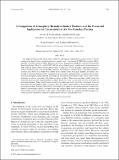A Comparison of Atmospheric Reanalysis Surface Products over the Ocean and Implications for Uncertainties in Air–Sea Boundary Forcing
Author(s)
Chaudhuri, Ayan H.; Ponte, Rui M.; Forget, Gael; Heimbach, Patrick
DownloadChaudhuri-2013-A Comparison of Atmo.pdf (3.435Mb)
PUBLISHER_POLICY
Publisher Policy
Article is made available in accordance with the publisher's policy and may be subject to US copyright law. Please refer to the publisher's site for terms of use.
Terms of use
Metadata
Show full item recordAbstract
This paper investigates the uncertainties related to atmospheric fields from reanalysis products used in forcing ocean models. Four reanalysis products, namely from 1) the interim ECMWF Re-Analysis (ERA-Interim), 2) version 2 of the Common Reference Ocean–Ice Experiments (CORE2), 3) the 25-Year Japanese Reanalysis Project (JRA-25), and 4) NCEP–NCAR, are evaluated against satellite-derived observations for eight different fields (zonal and meridional winds, precipitation, specific humidity, continental discharge, surface air temperature, and downwelling longwave and shortwave radiation fluxes). No single product is found to agree better in all fields with satellite-derived observations. Reanalysis products are mostly comparable to each other because of their similar physical assumptions and assimilation of common observations. Adjusted atmospheric fields from the Estimating the Circulation and Climate of the Ocean (ECCO) optimizations are also in agreement with other reanalysis products. Time-mean and time-variable errors are estimated separately and mapped globally in space, based on 14-day average fields to focus on monthly to interannual periods. Time-variable errors are larger in comparison to the signal than time-mean errors for most fields, thus justifying the need to separate them for studying uncertainties as well as formulating optimization procedures. Precipitation and wind stress fields show significant time-mean and time-variable errors whereas downwelling radiation, air temperature, and humidity fields show small time-mean errors but large time-variable errors, particularly in the tropics. Uncertainties based on evaluating multiple products presented here are considerably larger than uncertainties based on single product pairs.
Date issued
2013-01Department
Massachusetts Institute of Technology. Department of Earth, Atmospheric, and Planetary SciencesJournal
Journal of Climate
Publisher
American Meteorological Society
Citation
Chaudhuri, Ayan H., Rui M. Ponte, Gael Forget, and Patrick Heimbach. “A Comparison of Atmospheric Reanalysis Surface Products over the Ocean and Implications for Uncertainties in Air–Sea Boundary Forcing.” Journal of Climate 26, no. 1 (January 2013): 153-170. © 2013 American Meteorological Society
Version: Final published version
ISSN
0894-8755
1520-0442